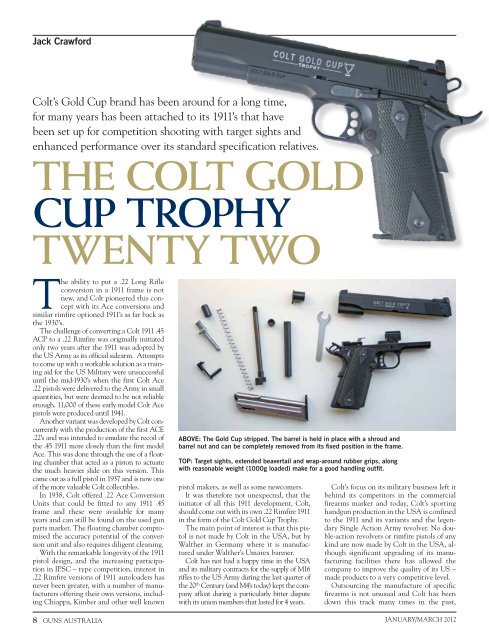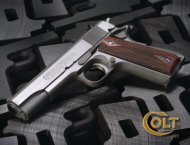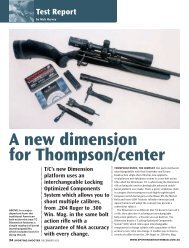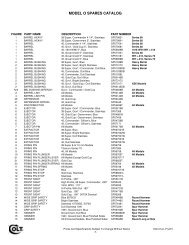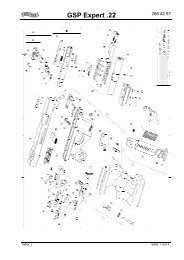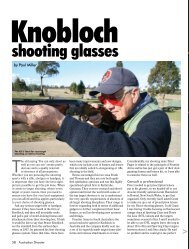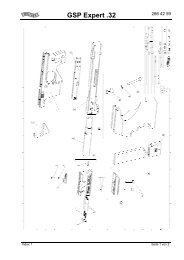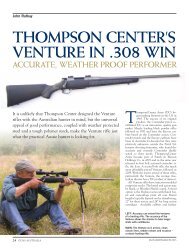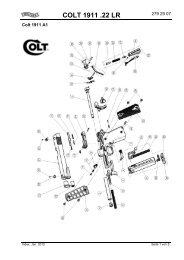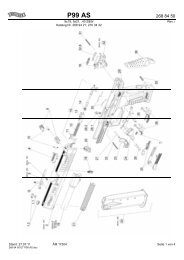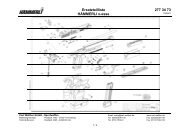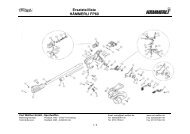The Colt Gold Cup Trophy Twenty Two - Frontier Arms
The Colt Gold Cup Trophy Twenty Two - Frontier Arms
The Colt Gold Cup Trophy Twenty Two - Frontier Arms
You also want an ePaper? Increase the reach of your titles
YUMPU automatically turns print PDFs into web optimized ePapers that Google loves.
Jack Crawford<br />
<strong>Colt</strong>’s gold <strong>Cup</strong> brand has been around for a long time,<br />
for many years has been attached to its 1911’s that have<br />
been set up for competition shooting with target sights and<br />
enhanced performance over its standard specification relatives.<br />
<strong>The</strong> ColT <strong>Gold</strong><br />
<strong>Cup</strong> <strong>Trophy</strong><br />
TwenTy <strong>Two</strong><br />
the ability to put a .22 long Rifle<br />
conversion in a 1911 frame is not<br />
new, and <strong>Colt</strong> pioneered this concept<br />
with its Ace conversions and<br />
similar rimfire optioned 1911’s as far back as<br />
the 1930’s.<br />
the challenge of converting a <strong>Colt</strong> 1911 .45<br />
ACP to a .22 Rimfire was originally initiated<br />
only two years after the 1911 was adopted by<br />
the Us Army as its official sidearm. Attempts<br />
to come up with a workable solution as a training<br />
aid for the Us Military were unsuccessful<br />
until the mid-1930’s when the first <strong>Colt</strong> Ace<br />
.22 pistols were delivered to the Army in small<br />
quantities, but were deemed to be not reliable<br />
enough. 11,000 of these early model <strong>Colt</strong> Ace<br />
pistols were produced until 1941.<br />
Another variant was developed by <strong>Colt</strong> concurrently<br />
with the production of the first ACE<br />
.22’s and was intended to emulate the recoil of<br />
the .45 1911 more closely than the first model<br />
Ace. this was done through the use of a floating<br />
chamber that acted as a piston to actuate<br />
the much heavier slide on this version. this<br />
came out as a full pistol in 1937 and is now one<br />
of the more valuable <strong>Colt</strong> collectibles.<br />
in 1938, <strong>Colt</strong> offered .22 Ace Conversion<br />
Units that could be fitted to any 1911 .45<br />
frame and these were available for many<br />
years and can still be found on the used gun<br />
parts market. the floating chamber compromised<br />
the accuracy potential of the conversion<br />
unit and also requires diligent cleaning.<br />
With the remarkable longevity of the 1911<br />
pistol design, and the increasing participation<br />
in iPsC – type competition, interest in<br />
.22 Rimfire versions of 1911 autoloaders has<br />
never been greater, with a number of manufacturers<br />
offering their own versions, including<br />
Chiappa, Kimber and other well known<br />
8 gUNs AUstRAliA<br />
ABOVE: <strong>The</strong> <strong>Gold</strong> <strong>Cup</strong> stripped. <strong>The</strong> barrel is held in place with a shroud and<br />
barrel nut and can be completely removed from its fixed position in the frame.<br />
TOP: Target sights, extended beavertail and wrap-around rubber grips, along<br />
with reasonable weight (1000g loaded) make for a good handling outfit.<br />
pistol makers, as well as some newcomers.<br />
it was therefore not unexpected, that the<br />
initiator of all this 1911 development, <strong>Colt</strong>,<br />
should come out with its own .22 Rimfire 1911<br />
in the form of the <strong>Colt</strong> gold <strong>Cup</strong> trophy.<br />
the main point of interest is that this pistol<br />
is not made by <strong>Colt</strong> in the UsA, but by<br />
Walther in germany where it is manufactured<br />
under Walther’s Umarex banner.<br />
<strong>Colt</strong> has not had a happy time in the UsA<br />
and its military contracts for the supply of M16<br />
rifles to the Us Army during the last quarter of<br />
the 20 th Century (and M4’s today) kept the company<br />
afloat during a particularly bitter dispute<br />
with its union members that lasted for 4 years.<br />
<strong>Colt</strong>’s focus on its military business left it<br />
behind its competitors in the commercial<br />
firearms market and today, <strong>Colt</strong>’s sporting<br />
handgun production in the UsA is confined<br />
to the 1911 and its variants and the legendary<br />
single Action Army revolver. No double-action<br />
revolvers or rimfire pistols of any<br />
kind are now made by <strong>Colt</strong> in the UsA, although<br />
significant upgrading of its manufacturing<br />
facilities there has allowed the<br />
company to improve the quality of its Us –<br />
made products to a very competitive level.<br />
Outsourcing the manufacture of specific<br />
firearms is not unusual and <strong>Colt</strong> has been<br />
down this track many times in the past,<br />
JANUARY/MARCH 2012
with its <strong>Colt</strong> branded bolt action rifles made<br />
by sauer in germany and its cap and ball<br />
handguns made in italy by Uberti. <strong>Colt</strong><br />
could not go wrong using Walther to source<br />
this .22 gold <strong>Cup</strong>, and its performance in<br />
the tests backed that up.<br />
the gold <strong>Cup</strong> .22 is a very clever design<br />
and is truly a 1911 from the slide rails down.<br />
the trigger system, grip safety, hammer spring<br />
system and safety arrangement are as close to<br />
the original 1911 specifications as possible.<br />
the main difference obviously lies in the rimfire<br />
barrel/recoil spring requirements. the action<br />
is direct blowback and not a locked breech arrangement<br />
as is the case on the centrefire 1911’s.<br />
An integral breech block on the frame supports<br />
the rigid barrel and although the action is a direct<br />
blow back design, the barrel bushing on the<br />
slide operates identically to a centrefire 1911,<br />
with the bushing being removable.<br />
the way the barrel is attached to the<br />
frame is similar to the Dan Wesson system.<br />
the rifled section of the barrel is a slender<br />
tube that fits neatly inside the barrel sleeve.<br />
the barrel’s muzzle is threaded and a nut tensions<br />
the barrel against the sleeve and locks<br />
it into the breech block on the frame. this<br />
makes for a very rigid barrel setup without<br />
having to use a heavy barrel or more complicated<br />
frame attachment arrangements.<br />
the slide on the gold <strong>Cup</strong> is aluminium<br />
alloy as is the frame, but the pistol weighs<br />
close to 1000g with empty magazine insert-<br />
10 gUNs AUstRAliA<br />
lEFT: <strong>The</strong> <strong>Gold</strong> <strong>Cup</strong> digested all<br />
these types of rimfire ammo without<br />
a problem, delivering best accuracy<br />
with standard velocity loads.<br />
BElOW: A very useful accessory is<br />
the magazine loader that depresses<br />
the follower and facilitates filling the<br />
10 shot magazine.<br />
With the slide removed, the<br />
method of barrel attachment can<br />
be seen. A special spanner is<br />
supplied to fit the barrel nut.<br />
ed, which is not all that much different to a<br />
centrefire 1911.<br />
sights are fully adjustable with a square<br />
blade front sight set in a dovetail in the slide.<br />
Accessories included with the gold <strong>Cup</strong> include<br />
a barrel nut spanner so that the barrel<br />
can be removed from the frame and small<br />
hex spanners for locking the front and rear<br />
sight in place. A really neat item is the magazine<br />
loader – a polymer unit that fits over the<br />
magazine and facilitates pushing the follower<br />
down when loading the ten-shot magazine.<br />
the gold <strong>Cup</strong> was tested with a variety of<br />
.22 long Rifle ammunition – both standard<br />
and High velocity. Most of these .22 Rimfire<br />
clones of centrefire autoloaders are specifically<br />
set up to function with HV ammunition<br />
and will not work with standard velocity<br />
rimfire ammo. the gold <strong>Cup</strong> is an<br />
exception and worked perfectly with all<br />
types of ammo used in the tests. With respect<br />
to accuracy, it had a distinct preference for<br />
standard velocity target ammunition, consistently<br />
grouping under 50 mm at 25 metres<br />
on spite of its extremely heavy trigger that<br />
made precision shooting difficult. it was not<br />
so happy with the HV loads which were almost<br />
twice the group size of the standard<br />
velocity loads, mainly due to flyers, which<br />
may be more related to the consistency of the<br />
ammo rather than the pistol.<br />
My RCBs trigger pull gauge almost went<br />
off the scale with the gold <strong>Cup</strong>’s trigger, in-<br />
SPecS<br />
COlT GOld CuP TrOPhy<br />
Calibre:<br />
.22 Long Rifle<br />
Manufacturer:<br />
Walther (Umarex)<br />
Action:<br />
Blow-back autoloading<br />
Barrel length:<br />
127mm<br />
length:<br />
225mm<br />
height:<br />
140mm<br />
Width:<br />
35 mm<br />
Weight:<br />
940g without magazine<br />
Grips:<br />
Wrap-around rubber<br />
Sights:<br />
adjustable rear.<br />
Windage adjustable front<br />
Magazine:<br />
10 shot – stainless steel<br />
(1 supplied)<br />
Trigger:<br />
Single action non-adjustable<br />
rrP:<br />
Less than $1000 – shop around<br />
dicating a release weight of nearly 8lb. i am<br />
sure the pistol would deliver better groups<br />
given a issF compliant (1000g) trigger pull,<br />
and an owner would find a trigger job on this<br />
pistol a good investment. Fortunately, the<br />
1911–type trigger is easy to work on and any<br />
experienced pistol smith should be able to<br />
sort out a lighter trigger release if required.<br />
there are two other models listed in the<br />
<strong>Colt</strong>/Walther .22 range – a government Model<br />
with standard original fixed military sights<br />
and a Rail gun with an accessory rail under<br />
the front of the frame and a Novak-type combat<br />
rear sight. the adjustable sights on the<br />
gold <strong>Cup</strong> would put it at the top of my list.<br />
in any event, the accuracy with the gold<br />
<strong>Cup</strong> was the best achieved so far with a rimfire<br />
autoloader of the 1911 kind and it offers an<br />
economical and practical practice option for<br />
those shooting the iPsC and Action matches.<br />
<strong>Colt</strong> (and Walther) forearms are distributed<br />
throughout Australia by <strong>Frontier</strong> <strong>Arms</strong> Company.<br />
Web: www.frontierarms.com.au<br />
JANUARY/MARCH 2012


